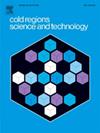基于轴向张力测量的10kv架空配电线路结冰监测技术及应用
IF 3.8
2区 工程技术
Q1 ENGINEERING, CIVIL
引用次数: 0
摘要
架空配电线路覆冰严重影响配电网的安全运行。针对我国南方山区常见的 10 千伏应变杆塔结构特点,缺乏对 10 千伏架空配电线路,特别是小跨距线路覆冰监测方法,本文提出了一种基于导线轴向拉力测量的 10 千伏架空配电线路等效覆冰厚度(EIT)实时监测技术。考虑到结冰前后导体垂直跨度的变化,提出了覆冰导体等效冰厚的计算方法。然后,在贵州开发并安装了覆冰架空配电线路结冰监测装置,并利用典型监测数据分析了环境对拉力的影响。通过与人工覆冰观测结果和覆冰线路照片的对比,验证了监测技术的有效性和计算方法的准确性。最后,将本文方法与 110 kV 及以上电压等级输电线路采用的不考虑导线垂直跨度变化的覆冰导线 EIT 计算方法进行比较,发现本文方法考虑了导线垂直跨度的变化,能显著提高小跨度下 EIT 的计算精度,更适合应用于架空配电线路。本文章由计算机程序翻译,如有差异,请以英文原文为准。
Icing monitoring technology and application of 10 kV overhead distribution lines based on axial tension measurement
Severe ice cover on overhead distribution lines affects the safe operation of the distribution network. Aiming at the lack of icing monitoring methods for 10 kV overhead distribution lines with strain towers, especially those with small spans, in consideration of the structural characteristics of 10 kV strain towers commonly found in mountainous areas of southern China, this paper proposes a real-time monitoring technology of equivalent ice thickness (EIT) of 10 kV overhead distribution lines based on axial tension measurement of the conductors. Considering variations in vertical spans of conductors before and after icing, a calculation method for EIT of ice-covered conductors is presented. Then an icing monitoring device for ice-covered overhead distribution lines has been developed and installed in Guizhou, and typical monitoring data is used to analyze environmental impacts on tension. The validity of the monitoring technology and accuracy of the calculation method are verified through comparison with artificial ice observation results and ice-covered lines photographs. Finally, comparing the method of this paper and the method of calculating the EIT of ice-covered conductors without considering the change of vertical spans of transmission conductors adopted for voltage levels of 110 kV and above, it is found that the method of this paper, considering the changes of vertical spans of conductors, can significantly improve the accuracy of calculating the EIT under the small span, making it more suitable for application to overhead distribution lines.
求助全文
通过发布文献求助,成功后即可免费获取论文全文。
去求助
来源期刊

Cold Regions Science and Technology
工程技术-地球科学综合
CiteScore
7.40
自引率
12.20%
发文量
209
审稿时长
4.9 months
期刊介绍:
Cold Regions Science and Technology is an international journal dealing with the science and technical problems of cold environments in both the polar regions and more temperate locations. It includes fundamental aspects of cryospheric sciences which have applications for cold regions problems as well as engineering topics which relate to the cryosphere.
Emphasis is given to applied science with broad coverage of the physical and mechanical aspects of ice (including glaciers and sea ice), snow and snow avalanches, ice-water systems, ice-bonded soils and permafrost.
Relevant aspects of Earth science, materials science, offshore and river ice engineering are also of primary interest. These include icing of ships and structures as well as trafficability in cold environments. Technological advances for cold regions in research, development, and engineering practice are relevant to the journal. Theoretical papers must include a detailed discussion of the potential application of the theory to address cold regions problems. The journal serves a wide range of specialists, providing a medium for interdisciplinary communication and a convenient source of reference.
 求助内容:
求助内容: 应助结果提醒方式:
应助结果提醒方式:


